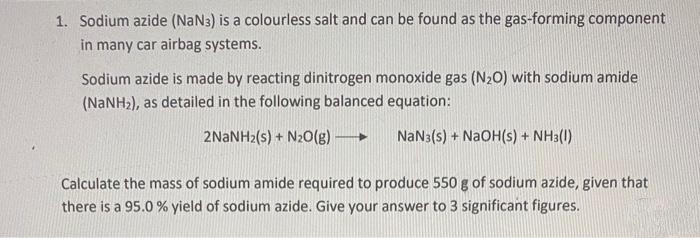1. Sodium azide (NaN3) is a colourless salt and can be found as the gas-forming component in many car airbag systems. Sodium azide is made by reacting dinitrogen monoxide gas (N20) with sodium amide (NANH2), as detailed in the following balanced equation: 2NANH2(s) + N2O(g) NaN3(s) + NaOH(s) + NH3(1) Calculate the mass of sodium amide required to produce 550 g of sodium azide, given that there is a 95.0 % yield of sodium azide. Give your answer to 3 significant figures.
1. Sodium azide (NaN3) is a colourless salt and can be found as the gas-forming component in many car airbag systems. Sodium azide is made by reacting dinitrogen monoxide gas (N20) with sodium amide (NANH2), as detailed in the following balanced equation: 2NANH2(s) + N2O(g) NaN3(s) + NaOH(s) + NH3(1) Calculate the mass of sodium amide required to produce 550 g of sodium azide, given that there is a 95.0 % yield of sodium azide. Give your answer to 3 significant figures.
Chemistry
10th Edition
ISBN:9781305957404
Author:Steven S. Zumdahl, Susan A. Zumdahl, Donald J. DeCoste
Publisher:Steven S. Zumdahl, Susan A. Zumdahl, Donald J. DeCoste
Chapter3: Stoichiometry
Section: Chapter Questions
Problem 7RQ: Consider the hypothetical reaction between A2 and AB pictured below. What is the balanced equation?...
Related questions
Question
100%

Transcribed Image Text:1. Sodium azide (NaN3) is a colourless salt and can be found as the gas-forming component
in many car airbag systems.
Sodium azide is made by reacting dinitrogen monoxide gas (N20) with sodium amide
(NANH2), as detailed in the following balanced equation:
2NANH2(s) + N20(g)
NaN3(s) + NaOH(s) + NH3(1)
Calculate the mass of sodium amide required to produce 550 g of sodium azide, given that
there is a 95.0 % yield of sodium azide. Give your answer to 3 significant figures.
Expert Solution
This question has been solved!
Explore an expertly crafted, step-by-step solution for a thorough understanding of key concepts.
This is a popular solution!
Trending now
This is a popular solution!
Step by step
Solved in 2 steps

Knowledge Booster
Learn more about
Need a deep-dive on the concept behind this application? Look no further. Learn more about this topic, chemistry and related others by exploring similar questions and additional content below.Recommended textbooks for you

Chemistry
Chemistry
ISBN:
9781305957404
Author:
Steven S. Zumdahl, Susan A. Zumdahl, Donald J. DeCoste
Publisher:
Cengage Learning


Chemistry: An Atoms First Approach
Chemistry
ISBN:
9781305079243
Author:
Steven S. Zumdahl, Susan A. Zumdahl
Publisher:
Cengage Learning

Chemistry
Chemistry
ISBN:
9781305957404
Author:
Steven S. Zumdahl, Susan A. Zumdahl, Donald J. DeCoste
Publisher:
Cengage Learning


Chemistry: An Atoms First Approach
Chemistry
ISBN:
9781305079243
Author:
Steven S. Zumdahl, Susan A. Zumdahl
Publisher:
Cengage Learning

Chemistry for Engineering Students
Chemistry
ISBN:
9781337398909
Author:
Lawrence S. Brown, Tom Holme
Publisher:
Cengage Learning

Chemistry for Engineering Students
Chemistry
ISBN:
9781285199023
Author:
Lawrence S. Brown, Tom Holme
Publisher:
Cengage Learning

Introductory Chemistry: A Foundation
Chemistry
ISBN:
9781285199030
Author:
Steven S. Zumdahl, Donald J. DeCoste
Publisher:
Cengage Learning